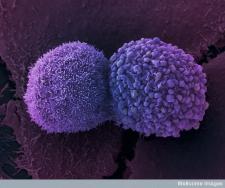Experimental Cancer Therapy Holds Great Promise — But at Great Cost
By Meghana Keshavan,
STAT
| 08. 23. 2016
Soon after she received the treatment, Karen Koehler’s brain swelled. Her blood pressure plummeted. As she fell into a coma, her husband and sister sat at her bedside — urging the doctors to keep pushing her farther along the razor’s edge between life and death.
Koehler was undergoing a promising — and terrifying — experimental therapy that her oncologists hoped could rid her body of cancer entirely. It’s called CAR-T therapy, and it works by engineering the patient’s own immune cells to attack cancer.
One of the hallmarks of CAR-T: It has to nearly kill you if it’s going to save you.
The treatment induces such sudden and severe side effects that it can take a small army of top specialists to keep patients alive while their newly engineered immune systems attack their cancer cells. The result: CAR-T remains so risky, so complex, and so difficult to manage that experts warn it’ll be years before it’s available to most patients who would stand to benefit — even though two drug makers, startup Kite Pharma and pharmaceutical giant Novartis...
Related Articles
By Emily Glazer, Katherine Long, Amy Dockser Marcus, The Wall Street Journal | 11.08.2025
For months, a small company in San Francisco has been pursuing a secretive project: the birth of a genetically engineered baby.
Backed by OpenAI chief executive Sam Altman and his husband, along with Coinbase co-founder and CEO Brian Armstrong, the startup—called...
By Jessica Hamzelou, MIT Technology Review | 11.07.2025
This week, we heard that Tom Brady had his dog cloned. The former quarterback revealed that his Junie is actually a clone of Lua, a pit bull mix that died in 2023.
Brady’s announcement follows those of celebrities like Paris...
By Emily Mullin, Wired | 10.30.2025
In 2018, Chinese scientist He Jiankui shocked the world when he revealed that he had created the first gene-edited babies. Using Crispr, he tweaked the genes of three human embryos in an attempt to make them immune to HIV and...
Public domain portrait of James D. Watson by Cold Spring Harbor Laboratory
and the National Human Genome Research Institute on Wikimedia Commons
James Watson, a scientist famous for ground-breaking work on DNA and notorious for expressing his antediluvian opinions, died on November 6, at the age of 97. Watson’s scientific eminence was primarily based on the 1953 discovery of the helical structure of DNA, for which he, Francis Crick and Maurice Wilkins shared the 1962 Nobel Prize in Physiology or...




